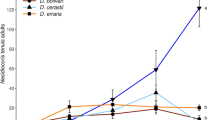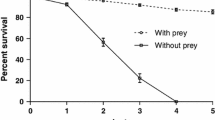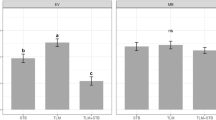Abstract
In recent years, biological control strategies to control many major horticultural pests have been successfully implemented in the Eastern Mediterranean basin. However, the management of some pests, such as aphids in sweet pepper crops, can still be improved. The goal of this study was to examine the potential of the omnivorous predatory mirids Nesidiocoris tenuis, Macrolophus pygmaeus, and Dicyphus maroccanus as biocontrol agents of aphids in sweet pepper crops. First, the capacity to detect Myzus persicae-infested and un-infested plants was studied in a Y-tube olfactometer. Females of the three species of predatory mirids were strongly attracted to the odor of infested M. persicae plants. Second, the prey suitability of young and mature nymphs of M. persicae for these three mirid species was studied. The three species actively preyed on M. persicae, although D. maroccanus resulted the most voracious species preying both young and mature nymphs. Finally, the capacity of the three omnivorous predators to reduce M. persicae in heavily infested plants was determined in semi-field conditions. The three species of mirids could reproduce on aphids and establish on sweet pepper plants. Mirids significantly reduced the number of M. persicae per leaf, reaching levels of aphid reduction close to 100 % when compared to the untreated control. These results suggest that mirids might play a major role in aphid management in sweet peppers. The potential implementation methods of predatory mirids for the biological control in sweet peppers are discussed.




Similar content being viewed by others
References
Alomar O, Goula M, Albajes R (2002) Colonisation of tomato fields by predatory mirid bugs (Hemiptera: Heteroptera) in northern Spain. Agric Ecosyst Environ 89:105–115
Alvarado P, Balta O, Alomar O (1997) Efficiency of four heteroptera as predators of Aphis gossypii and Macrosiphum euphorbiae (Hom.: Aphididae). Entomophaga 42:215–226
Arnó J, Gabarra R, Liu TX, Simmons AM, Gerling D (2010) Natural enemies of Bemisia tabaci: predators and parasitoids. In: Stansly PA, Naranjo SE (eds) Bemisia: bionomics and management of a global pest. Springer, Dordrecht-Heidelberg-London-New York, pp 385–421
Belliure B, Pérez P, Marcos MA, Michelena JM, Hermoso de Mendoza A (2008) Control biológico de pulgones. In: Jacas JA, Urbaneja A (eds) Control biológico de plagas agrícolas. Phytoma España, Valencia, España
Blom J (2008) Pimiento bajo abrigo. In: Jacas JA, Urbaneja A (eds) Control biológico de plagas agrícolas. Phytoma, Valencia, España, pp 399–409
Bueno VHP, van Lenteren JC, Lins JC, Calixto AM, Montes FC, Silva DB, Santiago LD, Pérez LM (2013) New records of Tuta absoluta (Meyrick) (Lepidoptera: Gelechiidae) predation by Brazilian hemipteran predatory bugs. J Appl Entomol 137:29–34
Calvo FJ, Bolckmans K, Belda JE (2009) Development of a biological control-based integrated pest management method for Bemisia tabaci for protected sweet pepper crops. Entomol Exp Appl 133:9–18
Calvo FJ, Bolckmans K, Belda JE (2011) Control of Bemisia tabaci and Frankliniella occidentalis in cucumber by Amblyseius swirskii. Biocontrol 56:185–192
Calvo FJ, Lorente MJ, Stansly PA, Belda JE (2012a) Preplant release of Nesidiocoris tenuis and supplementary tactics for control of Tuta absoluta and Bemisa tabaci in greenhouse tomato. Entomol Exp Appl 143:111–119
Calvo FJ, Soriano J, Bolckmans K, Belda JE (2012b) A successful method for whitefly and Tuta absoluta control in tomato. Evaluation after two years of application in practice. IOBC/WPRS Bull 80:237–244
Castañé C, Arnó J, Gabarra R, Alomar O (2011) Plant damage to vegetable crops by zoophytophagous mirid predators. Biol Control 59:22–29
Fantinou AA, Perdikis DC, Maselou DA, Lambropoulos PD (2008) Prey killing without consumption: does Macrolophus pygmaeus show adaptive foraging behaviour? Biol Control 47:187–193
Fantinou AA, Perdikis DC, Labropoulos PD, Maselou DA (2009) Preference and consumption of Macrolophus pygmaeus preying on mixed instar assemblages of Myzus persicae. Biol Control 51:76–80
Gonzalez-Cabrera J, Molla O, Monton H, Urbaneja A (2011) Efficacy of Bacillus thuringiensis (Berliner) in controlling the tomato borer, Tuta absoluta (Meyrick) (Lepidoptera: Gelechiidae). Biocontrol 56:71–80
Henderson CF, Tilton EW (1955) Tests with acaricides against the brown wheat mite. J Econ Entomol 48:157–161
Horsfall JL (1924) Life history studies of Myzus persicae sulzer. Pa Agric Exp Stn Bull 185:16
Huang NX, Enkegaard A, Osborne LS, Ramakers PMJ, Messelink GJ, Pijnakker J, Murphy G (2011) The banker plant method in biological control. Crit Rev Plant Sci 30:259–278
Ingegno BL, Pansa MG, Tavella L (2011) Plant preference in the zoophytophagous generalist predator Macrolophus pygmaeus (Heteroptera: Miridae). Biol Control 58:174–181
Jacas JA, Urbaneja A, García-Marí F (2008) Artrópodos depredadores. In: Jacas JA, Urbaneja A (eds) Control biológico de plagas agrícolas. Phytoma España, Valencia, España, pp 39–56
La-Spina M, Hermoso de Mendoza A, Carbonell E, Pérez-Panadés J (2008) Umbrales económicos de Myzus persicae (Hemiptera, Aphididae) sobre pimiento en invernadero comercial. Bol San Veg Plagas 34:485–491
Lykouressis DP, Perdikis DC, Gaspari MD (2007) Prey preference and biomass consumption of Macrolophus pygmaeus (Hemiptera: Miridae) fed Myzus persicae and Macrosiphum euphorbiae (Hemiptera: Aphididae). Eur J Entomol 104:199–204
McGregor RR, Gillespie DR (2004) Olfactory responses of the omnivorous generalist predator Dicyphus hesperus to plant and prey odours. Entomol Exp Appl 112:201–205
Messelink GJ, van Maanen R, van Steenpaal SEF, Janssen A (2008) Biological control of thrips and whiteflies by a shared predator: two pests are better than one. Biol Control 44:372–379
Messelink GJ, Bloemhard CMJ, Kok L, Janssen A (2011) Generalist predatory bugs control aphids in sweet pepper. IOBC/WPRS Bull 68:115–118
Messelink GJ, Bloemhard CMJ, Sabelis MW, Janssen A (2013) Biological control of aphids in the presence of thrips and their enemies. Biol Control 58:45–55
Moayeri HRS, Ashouri A, Brodsgaard HF, Enkegaard A (2006) Odour-mediated preference and prey preference of Macrolophus caliginosus between spider mites and green peach aphids. J Appl Entomol 130:504–508
Moayeri HRS, Ashouri A, Poll L, Enkegaard A (2007) Olfactory response of a predatory mirid to herbivore induced plant volatiles: multiple herbivory vs. single herbivory. J Appl Entomol 131:326–332
Molla O, Gonzalez-Cabrera J, Urbaneja A (2011) The combined use of Bacillus thuringiensis and Nesidiocoris tenuis against the tomato borer Tuta absoluta. Biocontrol 56:883–891
Mollá O, Biondi A, Alonso-Valiente M, Urbaneja A (2014) A comparative life history study of two mirid bugs preying on Tuta absoluta and Ephestia kuehniella eggs on tomato crops: implications for biological control. Biocontrol. doi:10.1007/s10526-013-9553-8
Perdikis D, Lykouressis D (2000) Effects of various items, host plants, and temperatures on the development and survival of Macrolophus pygmaeus rambur (Hemiptera: Miridae). Biol Control 17:55–60
Perdikis DC, Lykouressis DP (2002a) Life table and biological characteristics of Macrolophus pygmaeus when feeding on Myzus persicae and Trialeurodes vaporariorum. Entomol Exp Appl 102:261–272
Perdikis DC, Lykouressis DP (2002b) Thermal requirements for development of the polyphagous predator Macrolophus pygmaeus (Hemiptera: Miridae). Environ Entomol 31:661–667
Perdikis DC, Lykouressis DP (2004) Myzus persicae (Homoptera: Aphididae) as suitable prey for Macrolophus pygmaeus (Hemiptera: Miridae) population increase on pepper plants. Environ Entomol 33:499–505
Pineda A, Marcos-Garcia MA (2008) Evaluation of several strategies to increase the residence time of Episyrphus balteatus (Diptera, Syrphidae) releases in sweet pepper greenhouses. Ann Appl Biol 152:271–276
Ramakers PMJ, Rabasse JM (1995) Integrated pest management in protected cultivation. In: Reuveni R (ed) Novel approaches to integrated pest management. CRC Press, Florida, pp 199–229
Sanchez JA, La-Spina M, Michelena JM, Lacasa A, de Mendoza AH (2011) Ecology of the aphid pests of protected pepper crops and their parasitoids. Biocontrol Sci Technol 21:171–188
Symondson WOC, Sunderland KD, Greenstone MH (2002) Can generalist predators be effective biocontrol agents? Annu Rev Entomol 47:561–594
Urbaneja A, Gonzalez-Cabrera J, Arno J, Gabarra R (2012) Prospects for the biological control of Tuta absoluta in tomatoes of the Mediterranean basin. Pest Manag Sci 68:1215–1222
Valderrama K, Granobles J, Valencia E, Sanchez M (2007) Nesidiocoris tenuis (Hemiptera: Miridae) predator in tobacco crops (Nicotiana tabacum). Rev Colomb Entomol 33:141–145
van Lenteren JC (2012) The state of commercial augmentative biological control: plenty of natural enemies, but a frustrating lack of uptake. Biocontrol 57:1–20
Vandekerkhove B, De Clercq P (2010) Pollen as an alternative or supplementary food for the mirid predator Macrolophus pygmaeus. Biol Control 53:238–242
Acknowledgments
We want to thank V. Pedroche and M. Alonso-Valiente (IVIA) for their technical assistance and J. Calvo and J.E. Belda (Koppert BS) for providing the N. tenuis and M. pygmaeus individuals. The research leading to these results has received funding from the Conselleria d’Agricultura, Pesca i Alimentació de la Generalitat Valenciana.
Conflict of interest
The authors declare that they have no conflict of interest.
Author information
Authors and Affiliations
Corresponding author
Additional information
Communicated by L. Shipp.
Rights and permissions
About this article
Cite this article
Pérez-Hedo, M., Urbaneja, A. Prospects for predatory mirid bugs as biocontrol agents of aphids in sweet peppers. J Pest Sci 88, 65–73 (2015). https://doi.org/10.1007/s10340-014-0587-1
Received:
Accepted:
Published:
Issue Date:
DOI: https://doi.org/10.1007/s10340-014-0587-1




